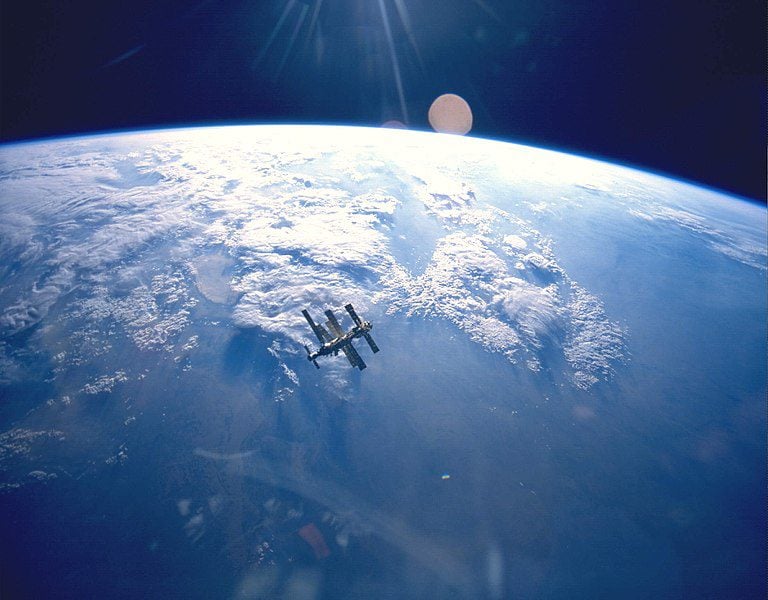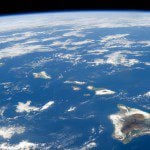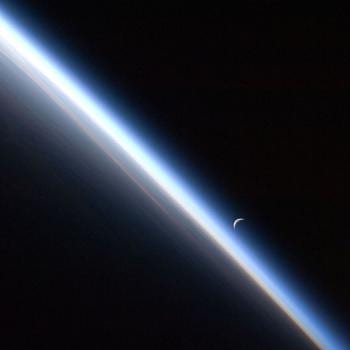
(NASA public domain photo)
Mir’s orbital altitude averaged about 223 miles above Earth’s surface.
I now resume my appropriation, for my own nefarious purposes — focused, as usual, on what I’m reliably informed are the two major themes of this blog (that is to say, on dishonest personal smears of people who don’t share my religious views and on food) — of material largely drawn from the online “List of Fine-Tuning Parameters” compiled by Jay W. Richards (though occasionally supplemented with things that I’ve culled from elsewhere). This is the fourth of the entries that I’ve taken from Dr. Richards’s list and that are explicitly dependent upon it. The first was this one: “An initial survey of the “four fundamental forces” and the “cosmological constant.””). My second was ““Initial Conditions and ‘Brute Facts.’”) And the third was “Local Planetary Conditions.”
As I said in all three of those blog posts, I claim no originality for these entries. And now, once more, I claim no originality for this one, either. Moreover, although I intend to expand and rework what I’ve begun in this regard, I may never claim any originality on the topic. (It’s not, after all, exactly my area of special expertise.) I do, however, intend to eventually rework these notes in successive stages as I draw upon and incorporate materials from other sources for a much larger project that I have in mind). The list from which I’m drawing these posts gives me a helpful outline that I will flesh out and, yes, as time goes on, probably modify — maybe substantially.
Dr. Richards follows his list of five “Cosmic Constants” with a list of four “Initial Conditions and ‘Brute Facts’.” Those were, respectively, the topics of my previous two entries. The third focused on a few of what he terms ““Local” Planetary Conditions.” This fourth entry will continue that latter discussion:
Even in a universe that is arguably fine-tuned at the overall or cosmic level, local conditions can and do vary dramatically. Conditions inside a star will be very different from conditions in interstellar or intergalactic space, which will, in turn, be quite different from those inside a black hole and quite distinct from those within a gaseous planet (like Jupiter or Saturn) of a rocky planet like Earth. Life exists on Earth, of course, but Jupiter and Mercury and the asteroid belt are almost certainly lifeless. Even in this fine-tuned universe — as critics of cosmic fine-tuning delight in pointing out (a point, in fact, to which I will respond at some future time) — the vast majority of places in the universe, to say nothing of space itself, are unsuited for life.
In an interesting book entitled The Privileged Planet, astronomer Guillermo Gonzalez and his co-author, Jay Richards himself, identify twelve broad, widely recognized fine-tuning factors that appear to be required to build a single, habitable planet. (A quite distinct book on a closely related subject — I own and have read both it and Privileged Planet — is Rare Earth: Why Complex Life is Uncommon in the Universe [2003], by paleontologist Peter D. Ward and astrophysicist Donald Brownlee, both of the University of Washington.) As it happens, every one of the dozen factors listed by Gonzalez and Richards can be found together in the Earth. And there may well be many more such factors. In fact, observes Richards, most of them could reasonably be split out to make sub-factors, since each of them contributes in multiple ways to the habitability of a planet. I discussed several of these required factors in my prior relevant entry, and I will mention three more of them here:
- Near co-rotation circle of galaxy, in circular orbit around galactic center — which enables a planet to avoid traversing parts of the galaxy that would be dangerous to it and even perhaps lethal to life on it.
- Within the galactic habitable zone — which permits a planet to have access to heavy elements while, at the same time, it remains safely away from the dangerous galactic center.
- During the cosmic habitable age — when heavy elements and active stars exist without too high a concentration of dangerous radiation events.
As Richards himself puts it,
This is a very basic list of “ingredients” for building a single, habitable planet. At the moment, we have only rough probabilities for most of these items. For instance, we know that less than ten percent of stars even in the Milky Way Galaxy are within the galactic habitable zone. And the likelihood of getting just the right kind of moon by chance is almost certainly very low, though we have no way of calculating just how low. What we can say is that the vast majority of possible locations in the visible universe, even within otherwise habitable galaxies, are incompatible with life.
It’s important to distinguish this local “fine-tuning” [as] different from cosmic fine-tuning. With cosmic fine-tuning, we’re comparing the actual universe as a whole with other possible but non-actual universes. And though theorists sometimes postulate multiple universes to try to avoid the embarrassment of a fine-tuned universe, we have no direct evidence that other universes exist. When dealing with our local planetary environment, however, we’re comparing it with other known or theoretically possible locations within the actual universe. That means that, given a large enough universe, perhaps you could get these local conditions at least once just by chance (though it would be “chance” tightly constrained by cosmic fine-tuning).
So that may somewhat weaken the argument from “local fine-tuning” to design. However, Richards and his Privileged Planet co-author, the astronomer Dr. Guillermo Gonzales, take an interesting further step in that book that I’m still weighing:
So does that mean that evidence of local fine-tuning is useless for inferring design? No. Gonzalez and Richards argue that we can still discern a purposeful pattern in local fine-tuning. As it happens, the same cosmic and local conditions, which allow complex observers to exist, also provide the best setting, overall, for scientific discovery. So complex observers will find themselves in the best overall setting for observing. You would expect this if the universe were designed for discovery, but not otherwise. So the fine-tuning of physical constants, cosmic initial conditions, and local conditions for habitability, suggests that the universe is designed not only for complex life, but for scientific discovery as well.













